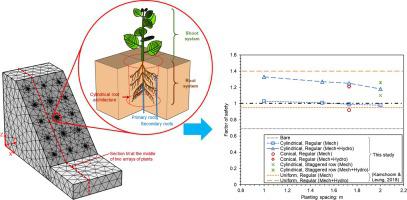当前位置:
X-MOL 学术
›
Comput. Geotech.
›
论文详情
Our official English website, www.x-mol.net, welcomes your feedback! (Note: you will need to create a separate account there.)
A new three-dimensional theoretical model for analysing the stability of vegetated slopes with different root architectures and planting patterns
Computers and Geotechnics ( IF 5.3 ) Pub Date : 2021-02-01 , DOI: 10.1016/j.compgeo.2020.103912 Charles W.W. Ng , Qi Zhang , Junjun Ni , Zeyu Li
Computers and Geotechnics ( IF 5.3 ) Pub Date : 2021-02-01 , DOI: 10.1016/j.compgeo.2020.103912 Charles W.W. Ng , Qi Zhang , Junjun Ni , Zeyu Li

|
Abstract The influence of root hydro-mechanical reinforcement on slope stability has commonly been modelled two-dimensionally. Moreover, the differentiation between primary and secondary roots is always ignored. This paper proposes a new three-dimensional (3D) theoretical model describing the effects of hydro-mechanical reinforcement of root systems on the stability of initially unsaturated soil slopes. Primary and secondary roots are differentiated within the root system. Root water uptake is modelled by considering root-soil hydraulic interactions. The theoretical model is implemented using the finite element method and calibrated with previous centrifuge results for a 3D vegetated slope. Three series of parametric analyses are carried out by considering (a) secondary root architecture, (b) plant spacing, and (c) planting pattern. The results show that, after 5-day transpiration, the conical root architecture induces higher suction and plant-plant interactions than the cylindrical root architecture. After rainfall with 1000-year return period, the differences in hydrological reinforcement vanish, while a lower factor of safety is found for the conical root architecture, mainly due to the smaller mechanical root reinforcement it provides. Additionally, the staggered row planting pattern with a large plant spacing of 2 m is recommended for bioengineering applications, as it affords greater mechanical reinforcement than does the regular pattern.
中文翻译:

一种新的三维理论模型,用于分析不同根系结构和种植模式的植被边坡稳定性
摘要 根部水力机械加固对边坡稳定性的影响通常采用二维建模。此外,主根和次生根之间的区别总是被忽略。本文提出了一种新的三维 (3D) 理论模型,用于描述根系的水力机械加固对初始非饱和土边坡稳定性的影响。初生根和次生根在根系内分化。通过考虑根 - 土壤水力相互作用来模拟根吸水。理论模型是使用有限元方法实现的,并使用先前离心机结果对 3D 植被坡度进行校准。通过考虑 (a) 次生根结构、(b) 植物间距和 (c) 种植模式进行三个系列的参数分析。结果表明,经过 5 天的蒸腾,锥形根结构比圆柱形根结构诱导更高的吸力和植物-植物相互作用。经过1000年重现期的降雨后,水文加固的差异消失,而锥形根结构的安全系数较低,主要是由于其提供的机械根加固较小。此外,建议在生物工程应用中使用 2 m 大株距的交错行种植模式,因为它比常规模式提供更大的机械加固。水文加固的差异消失了,而锥形根结构的安全系数较低,主要是由于它提供的机械根加固较小。此外,建议在生物工程应用中使用 2 m 大株距的交错行种植模式,因为它比常规模式提供更大的机械加固。水文加固的差异消失了,而锥形根结构的安全系数较低,主要是由于它提供的机械根加固较小。此外,建议在生物工程应用中使用 2 m 大株距的交错行种植模式,因为它比常规模式提供更大的机械加固。
更新日期:2021-02-01
中文翻译:

一种新的三维理论模型,用于分析不同根系结构和种植模式的植被边坡稳定性
摘要 根部水力机械加固对边坡稳定性的影响通常采用二维建模。此外,主根和次生根之间的区别总是被忽略。本文提出了一种新的三维 (3D) 理论模型,用于描述根系的水力机械加固对初始非饱和土边坡稳定性的影响。初生根和次生根在根系内分化。通过考虑根 - 土壤水力相互作用来模拟根吸水。理论模型是使用有限元方法实现的,并使用先前离心机结果对 3D 植被坡度进行校准。通过考虑 (a) 次生根结构、(b) 植物间距和 (c) 种植模式进行三个系列的参数分析。结果表明,经过 5 天的蒸腾,锥形根结构比圆柱形根结构诱导更高的吸力和植物-植物相互作用。经过1000年重现期的降雨后,水文加固的差异消失,而锥形根结构的安全系数较低,主要是由于其提供的机械根加固较小。此外,建议在生物工程应用中使用 2 m 大株距的交错行种植模式,因为它比常规模式提供更大的机械加固。水文加固的差异消失了,而锥形根结构的安全系数较低,主要是由于它提供的机械根加固较小。此外,建议在生物工程应用中使用 2 m 大株距的交错行种植模式,因为它比常规模式提供更大的机械加固。水文加固的差异消失了,而锥形根结构的安全系数较低,主要是由于它提供的机械根加固较小。此外,建议在生物工程应用中使用 2 m 大株距的交错行种植模式,因为它比常规模式提供更大的机械加固。



























 京公网安备 11010802027423号
京公网安备 11010802027423号